Chapter 9 - Nervous System Exercise 115
Question 1
Name the following:
(i) Nervous system including brain and spinal cord.
(ii) Sympathetic and parasympathetic jointly forms.
(iii) Terminal end of spinal cord.
(iv) The third neuron that is involved in reflexes, other than simple reflex.
(v) Study of structure and functions of nervous system.
(vi) Nerve which carry impulse from sensory receptor to CNS.
(vii) The nerve which carry impulse from CNS to muscles.
(viii) The peripheral matter of spinal nerve.
(ix) The peripheral matter of the brain.
(x) Outermost meningial membrane of spinal cord.
(xi) Structural and metabolic unit of nervous tissue.
(xii) The biological term given to the protective membranes of the brain.
(xiii) Cavity in which brain is situated.
(xiv) The neobrain.
(xv) The important centre of emotion.
(xvi) Paired lobes of midbrain related to the vision.
(xvii) Paired lobes of the brain related to the sense of smell.
(xviii) Fissure between the cerebral hemispheres.
(xix) Inability to write.
(xx) The busiest organ of the body.
(xxi) Inability to speak.
(xxii) The longest cranial nerve.
(xxiii) Thoracolumber region of spinal cord form.
(xxiv) Highly branched axon's end.
(xxv) Neuron only with axon.
(xxvi) White part of the eye.
(xxvii) Short sightedness.
(xxviii) Part of internal ear related to balance.
(xxix) The photosensitive pigment present in the rod cells of the retina.
(i) Nervous system including brain and spinal cord.
(ii) Sympathetic and parasympathetic jointly forms.
(iii) Terminal end of spinal cord.
(iv) The third neuron that is involved in reflexes, other than simple reflex.
(v) Study of structure and functions of nervous system.
(vi) Nerve which carry impulse from sensory receptor to CNS.
(vii) The nerve which carry impulse from CNS to muscles.
(viii) The peripheral matter of spinal nerve.
(ix) The peripheral matter of the brain.
(x) Outermost meningial membrane of spinal cord.
(xi) Structural and metabolic unit of nervous tissue.
(xii) The biological term given to the protective membranes of the brain.
(xiii) Cavity in which brain is situated.
(xiv) The neobrain.
(xv) The important centre of emotion.
(xvi) Paired lobes of midbrain related to the vision.
(xvii) Paired lobes of the brain related to the sense of smell.
(xviii) Fissure between the cerebral hemispheres.
(xix) Inability to write.
(xx) The busiest organ of the body.
(xxi) Inability to speak.
(xxii) The longest cranial nerve.
(xxiii) Thoracolumber region of spinal cord form.
(xxiv) Highly branched axon's end.
(xxv) Neuron only with axon.
(xxvi) White part of the eye.
(xxvii) Short sightedness.
(xxviii) Part of internal ear related to balance.
(xxix) The photosensitive pigment present in the rod cells of the retina.
Solution 1
(i) Central Nervous System
(ii) Autonomic Nervous System
(iii) Conus medullaris / Medullary cone
(iv) Mixed neurons
(v) Neuroscience
(vi) Sensory neurons
(vii) Motor neurons
(viii) White matter
(ix) White matter
(x) Dura mater
(xi) Neuron
(xii) Meninges
(xiii) Cranium
(xiv) Neocortex / Neopallium
(xv) Limbic system
(xvi) Corpora quadrigemina
(xvii) Olfactory Lobes
(xviii) Median fissure
(xix) Agraphia
(xx) Brain
(xxi) Aphasia
(xxii) Trigeminal nerve
(xxiii) Sympathetic nervous system
(xxiv) Dendrites
(xxv) Bipolar neuron
(xxvi) Sclera
(xxvii) Myopia
(xxviii) Semicircular canal
(xxix) Rhodopsin
(ii) Autonomic Nervous System
(iii) Conus medullaris / Medullary cone
(iv) Mixed neurons
(v) Neuroscience
(vi) Sensory neurons
(vii) Motor neurons
(viii) White matter
(ix) White matter
(x) Dura mater
(xi) Neuron
(xii) Meninges
(xiii) Cranium
(xiv) Neocortex / Neopallium
(xv) Limbic system
(xvi) Corpora quadrigemina
(xvii) Olfactory Lobes
(xviii) Median fissure
(xix) Agraphia
(xx) Brain
(xxi) Aphasia
(xxii) Trigeminal nerve
(xxiii) Sympathetic nervous system
(xxiv) Dendrites
(xxv) Bipolar neuron
(xxvi) Sclera
(xxvii) Myopia
(xxviii) Semicircular canal
(xxix) Rhodopsin
Chapter - Exercise
Solution 1
Solution 2
Chapter 9 - Nervous System Exercise 116
Question 1
Select the odd one in the following series:
(i) Retina, Sclera, Ciliary body, Nephron.
(ii) Endolymph, Tympanic membrane, Semi-circular canal, Blind spot.
(iii) Prosencephalon, Mesencephalon, Rhombencephalon, Myelin.
(iv) Cerebellum, Medulla oblongata, Olfactory lobe.
(v) Parasympathetic, Sympathetic, Cranial nerve.
(i) Retina, Sclera, Ciliary body, Nephron.
(ii) Endolymph, Tympanic membrane, Semi-circular canal, Blind spot.
(iii) Prosencephalon, Mesencephalon, Rhombencephalon, Myelin.
(iv) Cerebellum, Medulla oblongata, Olfactory lobe.
(v) Parasympathetic, Sympathetic, Cranial nerve.
Solution 1
(i) Nephron
(ii) Blind spot
(iii) Myelin
(iv) Olfactory lobe
(v) Cranial nerve
(ii) Blind spot
(iii) Myelin
(iv) Olfactory lobe
(v) Cranial nerve
Question 2
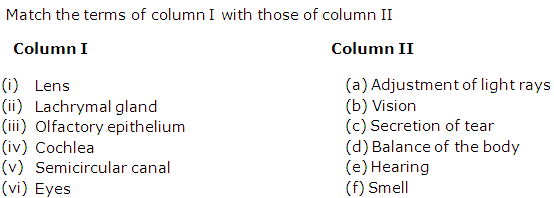
Solution 2

Question 3
Define the following:
(i) Nerve impulse
(ii) Axon
(iii) Cyton
(iv) Action potential
(v) Reflex action
(vi) Yellow spot
(vii) Blind spot
(viii) Power of accommodation
(i) Nerve impulse
(ii) Axon
(iii) Cyton
(iv) Action potential
(v) Reflex action
(vi) Yellow spot
(vii) Blind spot
(viii) Power of accommodation
Solution 3
(i) Nerve impulse - It is an electrochemical change occurring in the membrane of a nerve fibre produced by a stimulus.
(ii) Axon - It is a fibre like process of the neuron which carries impulses away from the cell body.
(iii) Cyton - It is an oval, angular, polygonal or stellate body which contains a large central nucleus.
(iv) Action potential - A momentary change in electrical potential on the surface of a cell, or a nerve or muscle cell, that occurs when it is stimulated, resulting in the transmission of an electrical impulse.
(v) Reflex action - It is an immediate and involuntary response to a stimulus.
(vi) Yellow spot - It is the region of best vision where more cone cells are present.
(vii) Blind spot - It is the region of no image formation because of lack of cone cells.
(viii) Power of accommodation - It is the ability of the lens to focus on far and distant objects.
(ii) Axon - It is a fibre like process of the neuron which carries impulses away from the cell body.
(iii) Cyton - It is an oval, angular, polygonal or stellate body which contains a large central nucleus.
(iv) Action potential - A momentary change in electrical potential on the surface of a cell, or a nerve or muscle cell, that occurs when it is stimulated, resulting in the transmission of an electrical impulse.
(v) Reflex action - It is an immediate and involuntary response to a stimulus.
(vi) Yellow spot - It is the region of best vision where more cone cells are present.
(vii) Blind spot - It is the region of no image formation because of lack of cone cells.
(viii) Power of accommodation - It is the ability of the lens to focus on far and distant objects.
Question 4
Distinguish between the following pairs of words:
(i) Nerve cell and neuroglia cell
(ii) Nervous system and hormonal system
(iii) Cranial nerve and spinal nerve
(iv) Cerebrum and cerebellum
(v) Adrenalin and acetylcholine
(vi) Motor and sensory nerve
(vii) Grey matter and white matter
(viii) Myopia and hypermetropia
(i) Nerve cell and neuroglia cell
(ii) Nervous system and hormonal system
(iii) Cranial nerve and spinal nerve
(iv) Cerebrum and cerebellum
(v) Adrenalin and acetylcholine
(vi) Motor and sensory nerve
(vii) Grey matter and white matter
(viii) Myopia and hypermetropia
Solution 4

Question 5
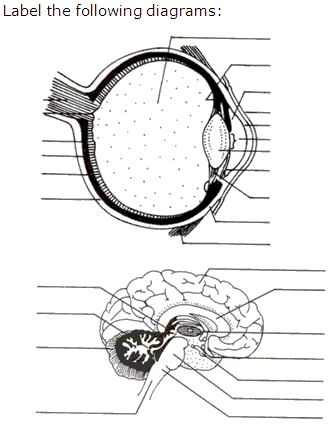
Solution 5
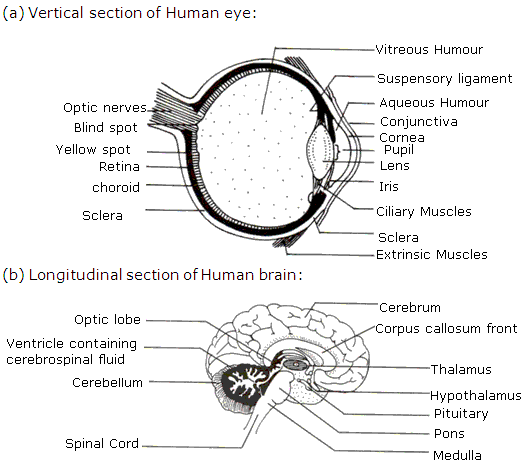
Chapter 9 - Nervous System Exercise 117
Question 1
(i) Draw a well-labelled diagram of the vertical section of mammalian brain.
(ii) Which part of the brain is the seat of body temperature regulation?
(iii) Name the part of the brain responsible for sense of smell and mental function of intelligence and memory.
(ii) Which part of the brain is the seat of body temperature regulation?
(iii) Name the part of the brain responsible for sense of smell and mental function of intelligence and memory.
Solution 1

Question 2
Draw a diagram of the side view of human brain and label the part which suits the following functions/ descriptions:
(i) It lies below and behind the cerebrum. It consists of three parts.
(ii) It is a cross-wise broad band of fibres which comments medulla oblongata, cerebellum and cerebrum.
(iii) It is the lower most and hinder part of the brain which continues below into spinal cord
(iv) It is a small thick-walled area which lies hidden below the cerebrum.
(v) It is the largest part of the brain which constitutes more than 80% and possesses 6-7 billion neurons.
(vi) It takes part in relaying sensory impulses and regulation of smooth muscle activity?
(i) It lies below and behind the cerebrum. It consists of three parts.
(ii) It is a cross-wise broad band of fibres which comments medulla oblongata, cerebellum and cerebrum.
(iii) It is the lower most and hinder part of the brain which continues below into spinal cord
(iv) It is a small thick-walled area which lies hidden below the cerebrum.
(v) It is the largest part of the brain which constitutes more than 80% and possesses 6-7 billion neurons.
(vi) It takes part in relaying sensory impulses and regulation of smooth muscle activity?
Solution 2
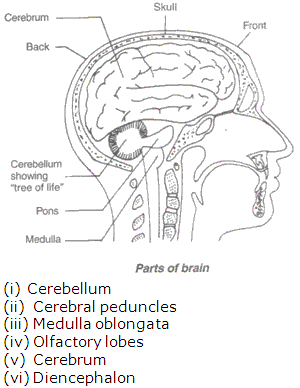
Chapter 9 - Nervous System Exercise 118
Question 1
Where are these located?
(i) Meninges
(ii) Ganglia
(iii) Cerebellum
(iv) Nodes of Ranvier
(v) Effector organs
(i) Meninges
(ii) Ganglia
(iii) Cerebellum
(iv) Nodes of Ranvier
(v) Effector organs
Solution 1
(i) Meninges - It is located around the brain and spinal cord.
(ii) Ganglia - It is located outside the brain and spinal cord.
(iii) Cerebellum - It is located behind cerebrum and above medulla oblongata in the brain.
(iv) Nodes of Ranvier - It is located on the unmyelinated areas on the axon.
(v) Effector organs - It is located in muscle , gland or any organ of the body.
(ii) Ganglia - It is located outside the brain and spinal cord.
(iii) Cerebellum - It is located behind cerebrum and above medulla oblongata in the brain.
(iv) Nodes of Ranvier - It is located on the unmyelinated areas on the axon.
(v) Effector organs - It is located in muscle , gland or any organ of the body.
Question 2
Draw a labelled diagram of the front view the human eye.
Solution 2
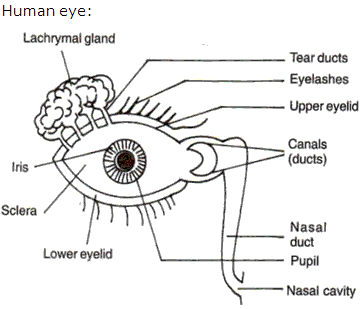
Question 3
Differentiate between nerve and neuron.
Solution 3

Question 4
Name the respective organs in which the following are located and mention the main function of each:
(i) Iris
(ii) Semicircular canals
(i) Iris
(ii) Semicircular canals
Solution 4
(i) Iris: It is located in the eye. Its function is to protect the eyeball and controls the size of the pupil.
(ii) Semicircular canals: It is located in the inner ear. These are concerned with the body equilibrium.
(ii) Semicircular canals: It is located in the inner ear. These are concerned with the body equilibrium.
Question 5
Give two examples of reflex actions in our daily life.
Solution 5
Following are the two examples of reflex actions in our daily life :
(i) Removing hand suddenly when pricked by a thorn.
(ii) Blinking of eyelids on exposure to light.
(i) Removing hand suddenly when pricked by a thorn.
(ii) Blinking of eyelids on exposure to light.
Question 6
(i) What is a reflex action?
(ii) Give one example of a conditioned reflex in your own life.
(ii) Give one example of a conditioned reflex in your own life.
Solution 6
(i) Reflex action - It is an immediate and involuntary response to a stimulus.
(ii) Example of a conditioned reflex: Tying one's shoe lace.
(ii) Example of a conditioned reflex: Tying one's shoe lace.
Question 7
The diagram alongside represents the structure of the human ear.
(i) Write the names of the parts labelled a to g.
(ii) State briefly the functions of the parts b, d, and g.
(iii) Name the main division of the ear.
(iv) Which is the smallest bone in the human body?
(v) What is labyrinth?

(i) Write the names of the parts labelled a to g.
(ii) State briefly the functions of the parts b, d, and g.
(iii) Name the main division of the ear.
(iv) Which is the smallest bone in the human body?
(v) What is labyrinth?

Solution 7
(i) (a) Bone of skull
(b) Inner ear
(c) Eardrum
(d) Bone of skull
(e) Bone of middle ear
(f) Middle ear
(g) Air filled
(ii) (b) Inner ear - It transmits the impulse to brain.
(d) Bone of skull - It helps in fixing the position of the ears to help the brain use auditory cues to judge direction and distance of sounds.
(g) Air filled - It keeps the pressure in the middle ear equalized with pressure in the outside.
(iii) The main division of the ear are: outer ear, middle ear and inner ear.
(iv) Stirrup
(v) The labyrinth is the inner ear which consists of utriculus, sacculus, cochlea and three semicircular canals.
(b) Inner ear
(c) Eardrum
(d) Bone of skull
(e) Bone of middle ear
(f) Middle ear
(g) Air filled
(ii) (b) Inner ear - It transmits the impulse to brain.
(d) Bone of skull - It helps in fixing the position of the ears to help the brain use auditory cues to judge direction and distance of sounds.
(g) Air filled - It keeps the pressure in the middle ear equalized with pressure in the outside.
(iii) The main division of the ear are: outer ear, middle ear and inner ear.
(iv) Stirrup
(v) The labyrinth is the inner ear which consists of utriculus, sacculus, cochlea and three semicircular canals.
Question 8
The diagram alongside represents the structure found in the inner ear. Study the same and then answer the questions that follow:
(i) Name the parts labelled A, B, C and D.
(ii) Name the parts of the ear responsible for transmitting impulses to the brain.
(iii) Name the part labelled above which is responsible for:
1. Static equilibrium. 2. Dynamic equilibrium. 3. Hearing
(iv) Name the audio receptor cells which pick up vibrations.
(v) Name the fluid present in the inner ear.

(i) Name the parts labelled A, B, C and D.
(ii) Name the parts of the ear responsible for transmitting impulses to the brain.
(iii) Name the part labelled above which is responsible for:
1. Static equilibrium. 2. Dynamic equilibrium. 3. Hearing
(iv) Name the audio receptor cells which pick up vibrations.
(v) Name the fluid present in the inner ear.

Solution 8
(i) A - Semi-circular canal
B - Utriculus
C - Sacculus
D - Cochlea
(ii) Auditory nerve.
(iii) 1. Utriculus and sacculus
2. Semi-circular canal
3. Cochlea
(iv) Sensory cells of organ of Corti
(v) Perilymph
B - Utriculus
C - Sacculus
D - Cochlea
(ii) Auditory nerve.
(iii) 1. Utriculus and sacculus
2. Semi-circular canal
3. Cochlea
(iv) Sensory cells of organ of Corti
(v) Perilymph
Question 9
Give the main functions of each of the following:
(i) Cochlea
(ii) Fovea centralis
(iii) Three semicircular canals
(iv) Retina
(v) Lachrymal glands
(i) Cochlea
(ii) Fovea centralis
(iii) Three semicircular canals
(iv) Retina
(v) Lachrymal glands
Solution 9
(i) Cochlea - It helps in hearing by transmitting impulses to the brain through auditory nerves.
(ii) Fovea centralis - It is a point at retina where more cone cells are concentrated and thus produces sharpest vision.
(iii) Three semicircular canals - It maintains the dynamic equilibrium.
(iv) Retina - It prevents the reflection of light.
(v) Lachrymal glands - It produces tear to lubricate the eyeball.
(ii) Fovea centralis - It is a point at retina where more cone cells are concentrated and thus produces sharpest vision.
(iii) Three semicircular canals - It maintains the dynamic equilibrium.
(iv) Retina - It prevents the reflection of light.
(v) Lachrymal glands - It produces tear to lubricate the eyeball.
Question 10
Give one point of difference between the following on the basis of what is indicated:
Cerebrum and spinal cord. (Arrangement of neurons)
Cerebrum and spinal cord. (Arrangement of neurons)
Solution 10
The arrangement of neurons in
Cerebrum: cytons are present outside and axons are inside
Spinal cord: cytons are present inside and axons are outside.
Cerebrum: cytons are present outside and axons are inside
Spinal cord: cytons are present inside and axons are outside.
Question 11
Describe briefly the functions of medulla oblongata.
Solution 11
Functions of medulla oblongata -
(i) It controls the involuntary activities like - respiration, circulation, digestion, etc.
(ii) It controls the dilation and constriction of blood vessels.
(i) It controls the involuntary activities like - respiration, circulation, digestion, etc.
(ii) It controls the dilation and constriction of blood vessels.
Question 12
What is meant by 'reflex action'? Mention any two examples of reflex action occurring in day-to-day life.
Solution 12
Reflex action - It is an immediate and involuntary response to a stimulus.
Example - 1. Blinking of eyelids on exposure to light .
2. Knee jerk.
Example - 1. Blinking of eyelids on exposure to light .
2. Knee jerk.
Chapter 9 - Nervous System Exercise 119
Question 1
The diagram alongside represents a certain defect of vision of the human eye.
(i) Name the defect.
(ii) Describe briefly the condition in the eye responsible for the defect.
(iii) Redraw the figure by adding a suitable lens correcting the defect. Label the parts through which light-rays pass.
(iv) What special advantage do human beings derive in having both eyes facing forward?
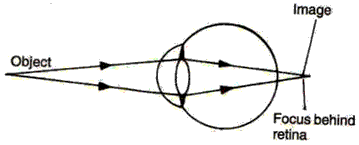
(i) Name the defect.
(ii) Describe briefly the condition in the eye responsible for the defect.
(iii) Redraw the figure by adding a suitable lens correcting the defect. Label the parts through which light-rays pass.
(iv) What special advantage do human beings derive in having both eyes facing forward?

Solution 1
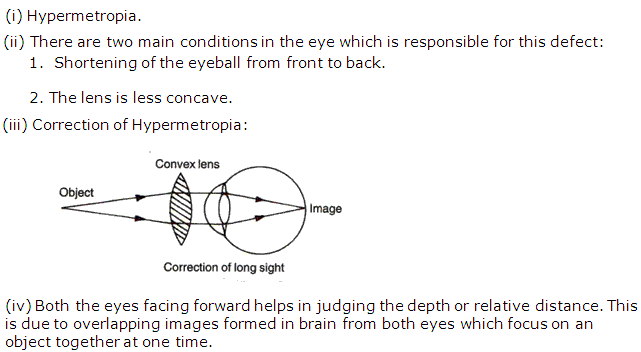
Question 2
Name the cells of the retina that are sensitive to colours.
Solution 2
Cone cells.
Question 3
The diagram alongside represents a section of a mammalian eye.
(i) Label the parts 1 to 5 of the diagram.
(ii) State the function of the parts labelled 4 and 5.
(iii) With the help of a diagram show the short sightedness.
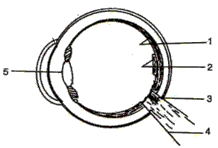
(i) Label the parts 1 to 5 of the diagram.
(ii) State the function of the parts labelled 4 and 5.
(iii) With the help of a diagram show the short sightedness.

Solution 3
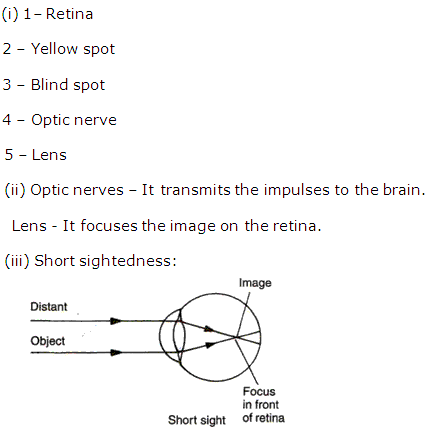
Question 4
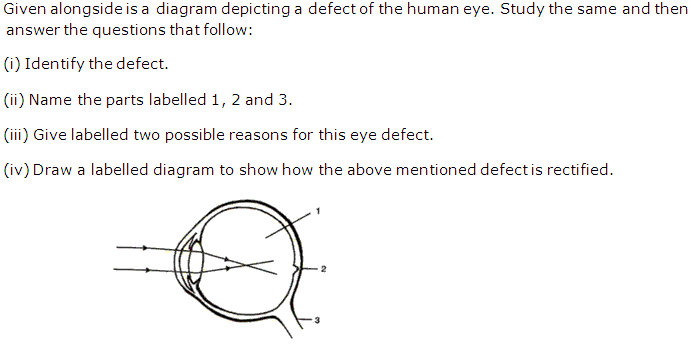
Solution 4
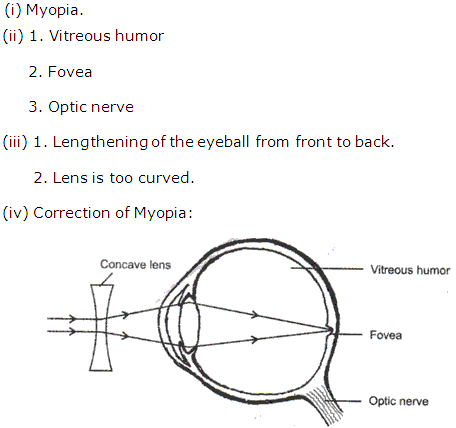
Question 5
Fill in the blanks with the function in the following:
Cochlea: ______
Meninges: ______
Cochlea: ______
Meninges: ______
Solution 5
(i) Cochlea: It helps in hearing by transmitting impulses to the brain through auditory nerves.
(ii) Meninges: It provides protection to brain and spinal cord.
(ii) Meninges: It provides protection to brain and spinal cord.
Question 6
Why does one feel blinded for a short while on coming out of a dark room?
Solution 6
One feels blinded for a short while on coming out of a dark room.This is called light adaptation of the eye.It is due to the constriction of the pupil to prevent the entry of light into the eye and pigment rhodopsin is bleached to reduce the sensitivity of the rods.
Question 7
Name the following:
(i) The opening through which light enters the eyes.
(ii) The fluid that is present inside and outside the brain.
(i) The opening through which light enters the eyes.
(ii) The fluid that is present inside and outside the brain.
Solution 7
(i) Iris
(ii) Cerebrospinal fluid
(ii) Cerebrospinal fluid
Question 8
Write whether the following are true or false:
(i) Axon of one neuron communicates with other nerve cell through synapse.
(ii) Neurotransmitters are released on activation.
(iii) Neurotransmitters are either broken down or reabsorbed after they have conducted an impulse.
(iv) All voluntary actions are controlled by the cerebellum.
(v) A convex lens is used for correcting myopia.
(vi) Rods are the receptor cells in the retina of the eye sensitive to dimlight.
(vii) The part of the ear associated with balance is the cochlea.
(viii) Vitreous chamber is present in ear in humans.
(i) Axon of one neuron communicates with other nerve cell through synapse.
(ii) Neurotransmitters are released on activation.
(iii) Neurotransmitters are either broken down or reabsorbed after they have conducted an impulse.
(iv) All voluntary actions are controlled by the cerebellum.
(v) A convex lens is used for correcting myopia.
(vi) Rods are the receptor cells in the retina of the eye sensitive to dimlight.
(vii) The part of the ear associated with balance is the cochlea.
(viii) Vitreous chamber is present in ear in humans.
Solution 8
(i) True
(ii) True
(iii) True
(iv) True
(v) False
(vi) True
(vii) False
(viii) False
(ii) True
(iii) True
(iv) True
(v) False
(vi) True
(vii) False
(viii) False
Chapter 9 - Nervous System Exercise 120
Question 1
Choose the correct answer.
(i) More than one foot long cells of the body are
(a) gland cell (b) RBC (c) bone cell (d) nerve cell
(ii) The largest part of the brain
(a) medulla (b) cerebrum (c) fornix (d) optic lobe
(iii) Number of spinal nerves in human beings
(a) 31 (b) 10 (c) 21 (d) 12
(iv) Number of cranial nerves
(a) 10 (b) 12 (c) 14 (d) 20
(v) Outermost covering of the brain is
(a) dura mater (b) pia mater (c) arachnoid (d) pericardium
(vi) Labyrinth is a part of
(a) ear (b) brain (c) nose (d) eye
(vii) In the chemistry of vision, the photosensitive substance is
(a) melanin (b) sclerotin (c) rhodopsin (d) none
(viii) Rods are receptor of
(a) twilight vision (b) colour vision (c) sound wave (d) odour
(ix) Which one is the photoreceptor
(a) organ of corti
(b) organ of sylvious
(c) cristae
(d) macula
(x) Synapse is a close proximity of
(a) two veins
(b) two arteries
(c) two muscles
(d) two nerves
(xi) Auditory nerve is responsible for
(a) smell (b) sight (c) hearing (d) none
(xii) Man has ______ pairs of spinal nerves.
(a)30 (b) 31 (c) 32 (d) 40
(xiii) Canal joining middle ear to pharynx
(a) eustachian
(b) tympanic
(c) labyrinth
(d) none
(xiv) Aperture controlling passage to light into the eye is
(a) blind spot
(b) pupil
(c) iris
(d) cornea
(xv) Colour is detected by
(a) rods (b) cones (c) pigment (d) choroids
(xvi) Organ of corti is found in
(a) eye (b) Ear (c) skin (d) none
(xvii) The cerebral hemispheres in mammals are connected by
(a) corpus luteum
(b) hypothalamus
(c) pons varolli
(d)corpus callosum
(xviii)Presbyopia is a disease of
(a) ear (b) nose (c) mouth (d) eye
(xix) The rods and cones of a vertebrate retina function is to
(a) focus light
(b) amplify light
(c) transduce light
(d) filter light
(xx) In mammals the corpus callosum connects
(a) the two optic lobes
(b) the two cerebral hemispheres
(c) the cerebrum to the cerebellum
(d) the pons to the medulla oblongata
(i) More than one foot long cells of the body are
(a) gland cell (b) RBC (c) bone cell (d) nerve cell
(ii) The largest part of the brain
(a) medulla (b) cerebrum (c) fornix (d) optic lobe
(iii) Number of spinal nerves in human beings
(a) 31 (b) 10 (c) 21 (d) 12
(iv) Number of cranial nerves
(a) 10 (b) 12 (c) 14 (d) 20
(v) Outermost covering of the brain is
(a) dura mater (b) pia mater (c) arachnoid (d) pericardium
(vi) Labyrinth is a part of
(a) ear (b) brain (c) nose (d) eye
(vii) In the chemistry of vision, the photosensitive substance is
(a) melanin (b) sclerotin (c) rhodopsin (d) none
(viii) Rods are receptor of
(a) twilight vision (b) colour vision (c) sound wave (d) odour
(ix) Which one is the photoreceptor
(a) organ of corti
(b) organ of sylvious
(c) cristae
(d) macula
(x) Synapse is a close proximity of
(a) two veins
(b) two arteries
(c) two muscles
(d) two nerves
(xi) Auditory nerve is responsible for
(a) smell (b) sight (c) hearing (d) none
(xii) Man has ______ pairs of spinal nerves.
(a)30 (b) 31 (c) 32 (d) 40
(xiii) Canal joining middle ear to pharynx
(a) eustachian
(b) tympanic
(c) labyrinth
(d) none
(xiv) Aperture controlling passage to light into the eye is
(a) blind spot
(b) pupil
(c) iris
(d) cornea
(xv) Colour is detected by
(a) rods (b) cones (c) pigment (d) choroids
(xvi) Organ of corti is found in
(a) eye (b) Ear (c) skin (d) none
(xvii) The cerebral hemispheres in mammals are connected by
(a) corpus luteum
(b) hypothalamus
(c) pons varolli
(d)corpus callosum
(xviii)Presbyopia is a disease of
(a) ear (b) nose (c) mouth (d) eye
(xix) The rods and cones of a vertebrate retina function is to
(a) focus light
(b) amplify light
(c) transduce light
(d) filter light
(xx) In mammals the corpus callosum connects
(a) the two optic lobes
(b) the two cerebral hemispheres
(c) the cerebrum to the cerebellum
(d) the pons to the medulla oblongata
Solution 1
(i) (d) nerve cell
(ii) (b) cerebrum
(iii) (a) 31
(iv) (b) 12
(v) (a) dura mater
(vi) (a) ear
(vii) (c) rhodopsin
(viii) (a) twilight vision
(ix) (d) macula
(x) (d) two nerves
(xi) (c) hearing
(xii) (b) 31
(xiii) (a) eustachian
(xiv) (c) iris
(xv) (b) cones
(xvi) (b) Ear
(xvii) (d) corpus callosum
(xviii) (d) eye
(xix) (d) filter light
(xx) (b) the two cerebral hemispheres
(ii) (b) cerebrum
(iii) (a) 31
(iv) (b) 12
(v) (a) dura mater
(vi) (a) ear
(vii) (c) rhodopsin
(viii) (a) twilight vision
(ix) (d) macula
(x) (d) two nerves
(xi) (c) hearing
(xii) (b) 31
(xiii) (a) eustachian
(xiv) (c) iris
(xv) (b) cones
(xvi) (b) Ear
(xvii) (d) corpus callosum
(xviii) (d) eye
(xix) (d) filter light
(xx) (b) the two cerebral hemispheres

0 comments:
Post a Comment